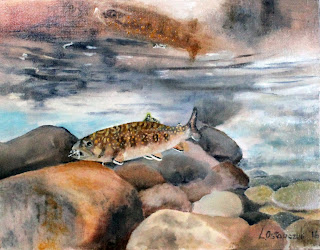Burroughs: The loose flow of the artwork below exhibits little
connection to John Burroughs’ harsh words about the landscape of the upper
Rondout. In his essay, A Bed of Boughs,
the Catskill naturalist wrote, “The scenery was wild and desolate in the
extreme, the mountains on either hand looking as if they had been swept by a
tornado of stone.” Perhaps only the most
astute observer might be able to locate this deeply shaded section of John
Burroughs’ Rondout Creek.
Burroughs,
11x14:











